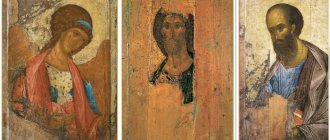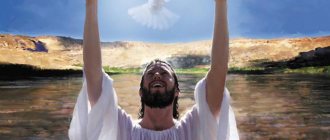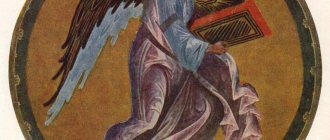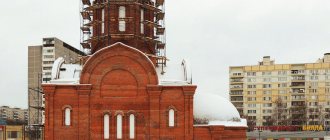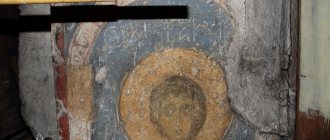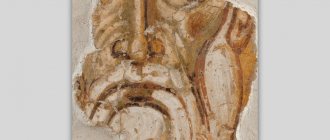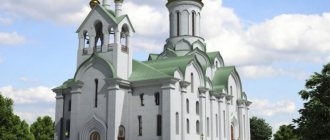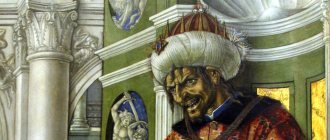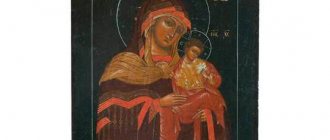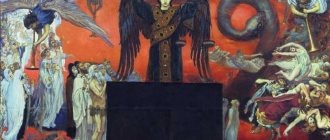There are dozens of options that will capture one significant event with paints on boards - the meeting of three wanderers. The history of the shrine is described in chapter 18 of the Book of Genesis and transferred to icons with symbolic meaning, either depicting scenes with Abraham and his wife, wanderers, or depicting the plot of the appearance of three angels before Abraham.
However, the most famous among all the icons is the icon of the Holy Trinity, representing the Trinity of God, painted by Andrei Rublev.
Icon of the Holy Trinity by Andrei Rublev and Fyodor Ushakov
The holy face plays a very important role for Christian believers, because this icon shows all of humanity what a strong connection can be when you really sincerely believe in it.
This icon is found only in Orthodoxy. It depicts the three Holy Spirits, who are represented as three travelers who met Abraham. This image was painted with one purpose, so that any Christian could clearly see Orthodoxy, which contains the three-solar world. Christian believers, looking at this icon, will be able to understand all the efforts and power of the Lord. After reading this article you will become familiar with: The meaning of the image, in what cases prayers are offered to it, in which churches it is kept, and so on.
Dear Brothers and Sisters, we will be very glad if you subscribe to our VKontakte group, there you will find even more prayers, icons and other interesting information, here is the address link - Orthodox group!
Andrey Rublev.
The best and most reliable of Rublev’s works is the famous “Trinity”.
Sergei of Radonezh built the Trinity Cathedral in his monastery, in which Rublev’s “Trinity” icon was then placed, “so that by looking at the Holy Trinity the fear of the hated discord of this world could be overcome.” It was a call for the unification of all Russian people - a call based on a deep philosophical awareness of the structure of the world and the moral unity of people.
Trinity was for Rublev not only the law of the geometric structure of the Universe, its dialectics, but also the ideal expression of love not closed by a double bond, and love open, including the entire universe. Three angels are collected in a triangle, the triangle is inscribed in an octahedron - a symbol of eternity, everything is united in a circle. The laws of gravity do not rule in this composition. The angels seem to be floating in the air, on their clothes, as if “written with smoke,” there are reflections of heavenly blue. In the gentle faces of the angels one can clearly sense high moral strength, the ability to lay down one’s life “for one’s friends.”
Three angels hover above the earth, their naked feet do not rest on the ground, their thinnest staffs are only symbols of wandering, reminding a person that he is only temporarily here on earth, and cannot take anything with him from here except his soul and what reigns in it truth.
The reflection of blue is the sky overturned in human nature. Life wisdom does not burden the angels, but makes them seem to rise above the world. And this is echoed by the supermundane radiance of colors. And that, perhaps, is why the sadness of Rublev’s angels is so joyful. This creation is easy to look at. It is no coincidence that Rublev himself wrote his “Trinity”, “steadily looking at the all-honorable icons, filled with joy and lightness.”
* * *
In the 1840s, historian N.D. Ivanchin-Pisarev, who visited the Trinity-Sergius Monastery and saw Rublev’s “Trinity” there, left the following entry in his travel notes: “Having venerated the main local icon of the Holy Trinity, I stood in front of it for a long time, marveling painting... It reveals in itself one of the best and most complete monuments... of art, for the style of drawing and painting itself seems to show in it the blooming time of this era. It can be honored with the glory of ancient Russian art.” The last words were truly prophetic. They anticipated the general view of the 20th century on this icon as one of the greatest works of world painting. So it cannot be said that the last century remained completely blind and distrustful of Rublev’s art and did not foresee future aesthetic discoveries in it.
* * *
Even D. A. Rovinsky, a well-known connoisseur and lover of ancient Russian art in the 19th century, seriously considered Rublev’s “Trinity” to be the work of an Italian master. He did not deny its high perfection, but even his consciousness was too dominated by naive “Eurocentrism”, which could not give up the idea that great art is inherent only in the Western European Renaissance tradition.
* * *
In 1904, an event took place in the Trinity-Sergius Lavra that was the first step towards the discovery of the original Rublev - an as yet incomplete, only partial restoration of the Rublev icon “Trinity” located in the Trinity Cathedral began, which was carried out by restorer V.P. Guryanov (*In this Restorers B. Tyulin and A. Izraztsov also took part in the work. In 1906, he published a small book where he talked about the progress and results of his work. This is an extremely interesting, moving testimony of the man who was the first to lift the centuries-old veil that covered Rublev’s creation. “At the end of 1904,” writes V.P. Guryanov, “I was invited to carry out the restoration of all the icons of the Trinity Cathedral under the supervision of the Imperial Moscow Archaeological Society. Father Archimandrite informed me that the restoration should be incomplete, that I had only to wash the icons and strengthen the damaged places on them, where it would be absolutely necessary, and correct them with paints. Knowing that the icons of the Trinity Cathedral had been corrected and written down more than once, I suggested that, in my opinion, all the icons should be carefully cleaned and then corrected. But this proposal of mine had to be abandoned out of necessity, since it required a lot of time and money...” Preparing for work, worrying, imagining the full extent of the responsibility, the restorer recalled the high marks given to the “Trinity” by scientists who had previously seen this icon...
The day came when the restoration was to begin. “From the Trinity,” we again turn to the memoirs of V.P. Guryanov, “the golden robe was removed... Imagine our surprise! Instead of an ancient and original monument, we saw an icon, completely recorded in the new style of the Palekhov manner of the 19th century... There is a doubt whether the icon written in this way really belongs to the brush of Andrei Rublev. After all, archaeological scientists speak so enthusiastically about it and point to it as the only and almost true icon of the work of this talented icon painter...” In front of the restorer there was indeed a famous icon, but completely recorded in more than one layer, most likely by the artist I. M. Malyshev, who In 1854, he supervised the renovation of icons and murals of the Trinity-Sergius Lavra. The book by V.P. Guryanov shows a photograph of the “Trinity” in the form in which it was opened from under the frame, supplemented by a description of the restorer himself: “On it the background and fields were... brown, and the inscriptions were gold, new... All the clothes of the angels were rewritten in a lilac tone and whitewashed not with paint, but with gold, the table, mountain and chambers were painted again... I decided to make a test, clean up the background between the mountain and the oak..."
Andrey Rublev. Trinity. Icon in a chasuble (in Godunov's setting).
Andrey Rublev. Trinity. Icon in 1904 with the cover just removed. The original painting is hidden under a layer of recording from the late 19th century. In the upper right corner in the background is a trial deletion of recordings made in 1904 (the head and shoulder of the right angel and the background with a slide).
And so the restorer, softening the upper layers not related to the author’s painting with lye or alcohol and carefully removing all the debris with a sharpened lancet knife in a small area, discovered that the background of the icon had been rewritten three times. In the photograph given in the book by V.P. Guryanov, four numbered stripes are visible. They differ from each other in color - the original background and three layers of renovations...
Andrey Rublev. Trinity. Icon during restoration in 1904.
Photo of “Trinity” after the completion of clearing Guryanov. 1904.
Photo of “Trinity” after Guryanov’s renovation, under a continuous Guryanov entry. 1905-1919.
Thus began the path to Rublev - not the legendary, but the real one. The “Trinity,” not fully revealed at that time, was subsequently restored twice more, in 1918 and 1926, before it took on its current form.
The current state of “Trinity” by Andrei Rublev. The picturesque surface of an icon today is a combination of layers of painting from different times.
After the partial discovery of the Trinity, the first attempts were made by art historians to give an artistic assessment of this work and determine its place in Russian and world painting. The ratings were exceptionally high: “The great brainchild of ancient Russian culture,” the icon “continues to excite researchers with the mysterious complexity of its style,” a work of “infinite grace of image,” the idea of the icon is “absolutely exceptional in depth and extremely complex in expression.”
The profound art connoisseur N. N. Punin called Rublev’s “Trinity” a “monument created by an unusually high creative will.” “We are amazed,” he wrote in the article “Andrei Rublev”, published in the second issue of the magazine “Apollo” for 1915, “the expressiveness and spontaneity of the concept, the language of painting itself, the living power of inspiration, and given such conditions there is no reason to deny the presence the genius who created this icon. This genius, the light of the early period of our painting, the sun that dominated the horizon for at least a century, could have been few...” At this time, none of the scientists dared to join the opinion of D. A. Rovinsky about the Italian author of “The Trinity” . Some researchers note the direct connection of this work with the flowering of culture that Byzantium, the southern Slavs and Rus' experienced in the 14th and early 15th centuries, but almost none of the art historians were able to rid themselves of the idea that Rublev’s art could do without Western European influences. The subsequent development of art criticism showed the inconsistency and unscientificness of opinions about the dependence of Russian icon painting on “samples of Gothic and Italian, in any case, Venetian forms” (N. N. Punin). Then it was still necessary to prove that ancient Russian art, being original and creating its own, deeply national ways of expression and ideals, was at the same time an organic part of a single Eastern European culture. But the naive stereotype of “Eurocentrism” already in the research of that time gradually began to be overcome; art historians are focusing attention on those aspects of the “Trinity” where one can see common properties of Old Russian and Italian painting, explained by their common origin from Byzantine art, which retained some ancient techniques.
Such confusion in determining the roots of Rublev’s art arose because the method of analyzing the works of the scientists who turned to the “Trinity” was ahistorical; the forms of painting were considered and compared in isolation from the worldview, the system of ideas that gave rise to them. One of our contemporary researchers of medieval culture writes: “Having done a lot of valuable things in the field of analyzing Rublev’s artistic techniques, most authors of the early 20th century revealed their inconsistency every time they tried to interpret the inner meaning of the work, its figurative content... They turned the “Trinity” into a work , devoid of any specific plot, created outside the historical environment and outside a certain artistic tradition” (I. E. Danilova).
* * *
He was already sixty by that time. The seventh decade of life is the time to take stock, to collect the ripest fruits of experience and skill. What he had experienced, everything that life had given him, was now embodied, multiplied by talent and work. There is a parable about the talents. It won’t take you long to remember what talent is. In ancient times, this was the name for a large measure of silver coins, a significant fortune. And the parable tells how a master, going to a distant country, entrusted his estate to his servants, giving them five talents to some, one to others, and two to others. And when he returned, he demanded an account of who used the wealth left behind for what purpose and how much he increased what he received. Only a careless servant who buried the money in the ground returned only what he received.
It’s time for him, Andrey, to give an answer about the talent he once received. May man at the end of his allotted journey be like a tree that bears fruit. It has come, imperceptibly it has come - the autumn time of life. Silence and peace in the soul. So I wouldn’t want to live until another, late autumn, without completing, without realizing everything, where it’s cold, windy, when a person is like “waterless clouds, like barren autumn trees, twice dead, uprooted...”.
Back in the spring, as soon as the artists arrived at the monastery, Andrei had a long, special conversation with the old abbot. Time has irrevocably absorbed the details of that conversation. The quiet voices of two old people who once sat on benches opposite each other in a wooden cell on Makovets fell silent. But what was said did not remain a secret either for Rublev’s brothers in the squad, or for the then Trinity monks. Nikon asked Andrei, it was him, and not anyone else, to paint the image of the Trinity, the main temple icon for the monastery cathedral. It is possible that this conversation was recorded somewhere. However, the record itself, if it existed, did not make it into the manuscripts known to us now, which were created close in time to this event. In unknown ways, either according to written sources, now lost, or in oral tradition - in stories that were passed down from generation to generation among the monks of the Trinity and Andronikov monasteries, but still the most significant thing from this conversation between the artist and his closest friend was not lost to historical memory student and heir of Sergius. There is evidence preserved in a small historical work of the 17th century, “Tales of the Holy Icon Painters,” that Nikon asked Rublev “to paint an image of the Most Holy Trinity in praise of his father Saint Sergius.” This most valuable evidence eventually became the key to Rublev’s “Trinity”, to its innermost plan. And for Andrei himself, painting the icon and thinking about it were permeated with the light of one idea, to which the entire life of Sergius, the founder of the first Trinity Monastery in Rus', was devoted.
The day came when he began to work on this icon. Seniority in the squad, of course, sometimes required breaking away for a short time for other concerns. But the head of the artists was still Daniil, and the position of Andrei, the second of the two main masters, now contributed in the best way to concentrated attention to the main work. He was given a spacious, bright cell to work in so that he could write in daylight.
Spring days are transparent and light. On some mornings there is bright sun, a still fresh chill, young leaves rustle in the wind. After a shared meal, go straight to work. The food in the monastery is not plentiful and meager this spring. But is he, at least a monk in his third decade, complaining about this? And who will complain when there is poverty all around, people have not yet recovered from hunger. It is also closer to the real ancient institutions - always fast before painting icons.
There are days when in the morning a cheerful heavy rain is knocking on the plank roofs. The water thunders in a stream through the gutters, gurgles, and chokes in the tubs placed at the corners of the cells. It’s cold for old, tired hands in unheated rooms. At other times, get some firewood, light a small stove in the corner with a few logs, and warm up. If it’s dark in the cell to start writing, then you can light a small lamp and sit down to read a book. In the twilight you can see an icon in the corner, right under the ceiling, along the walls there are wide wooden benches lined with vessels with drying oil, boxes with paints, glue, and brushes. But then a hot streak stretched from the window to the log wall, golden in the sunlight. It's time to get to work. The morning sun will not shine for long, sparkling in the drops on the grass near the porch, on the trees in the monastery fence. As soon as it dries out the wood of the buildings, a warm steam rises from the ground, covering everything with a transparent silver haze. And such days are bright in their own way. You can’t see the sun, but you can feel it – it’s not behind the distant dark clouds, but somewhere very close. It is about to shine with a soft, evenly and everywhere pearly glow. Days like these are the perfect time to think in silence. Go out of the monastery gates, sit on a bench, from where you can see the surroundings in a free circle, in full view. Coppices washed by the recent rain, a river meandering through the green banks below the hill, stripes of cultivated fields. Or before the evening, tired from work, take a break and walk through the field to the nearest forest. Stand at the boundary, where the golden spring primrose makes its way between stones and grass, under a young birch tree with a transparent, yellow-green canopy. By the evening it will get colder, and the sunset glow will shine for a short time. They will strike the bell on the hill, calling for the vespers.
Andrey Rublev. Trinity. State Tretyakov Gallery.
And in the cell, on a bench leaning against the wall, stands the completed “Trinity.” The icon is designed to be large in size. An unusually dense, thin gesso is already applied to the matting weave. Now that it is polished, the surface appears like marble. But the gesso along the margins and the upper half of the icon is already covered with gold leaf, finely forged, softly glowing. At the top, the gold is not laid all over; in some places its borders are uneven; large, irregularly shaped stripes of gesso are left without gold covering. If you come closer, you can see that Andrey has already marked out the outlines of the entire image with liquid paint. Here and there on this original drawing traces of corrections are visible. Somewhere the line is slightly straightened or, on the contrary, rounded, the object is slightly reduced or barely moved. There are few corrections; even from this original drawing, even a very experienced person in art, if he had looked at Andrey that day, would have seen something well understood, but still extraordinary, hitherto unseen. And it was not so much the rare proportionality, the reasonable beauty of the flexible sketches, which were easily discerned in the preliminary drawing, that were able to attract attention. Andrey has long been famous only for the gift given to him of the light melodious beauty of these rounded movements of the brush. What was marvelous was mainly something else: the future icon seemed to lack much of what was then customary to see on other “Trinities,” ours and the Greeks.
Indeed, Rublev began to paint something unlike before when the first outlines lay on the sparkling white gesso, although the fundamental principle, of course, was the same as that of other artists, previous and contemporary. ...Ever since he began to understand the word, Rublev knew this story. Having become familiar with book teaching, I read it many times in special collections - “Paremias”, which were intended for both church and home use. These were separate chapters, passages from the Bible, arranged in the order of calendar readings. In his time, there was also a complete translation of the book of Genesis, which contained this narrative. With rare details that cannot be found in Scripture itself, one could learn about it in another book. It was called Palea, from the Greek word “decrepit”, “ancient”. It was a retelling of biblical events, sometimes with interpretations and notes by Russian scribes. These Russian additions, called “accusations against the Jew,” interpreted the “old” in the “new”, Christian spirit. People have been reading Paleya for a long time, and in many ways they based their views on the Old Testament “canopies and images” on it. Paley was found in both monastic and secular scribes. And here, at the Trinity, if you sort through the boxes of stored manuscripts, perhaps you will find at least one list of it (*Among the manuscripts of the library of the Trinity-Sergius Monastery, a list has reached us that may have been here already in the time of Rublev. This Paley was rewritten in 1406 in the city of Kolomna by the scribe Vorsanuphius.). And Andrei knew well a considerable number of explanations of short biblical lines found in old “fatherly” books. For many centuries, human thought was riveted to this story, which seemed to stand out in no way from many other ancient legends... There lived an old nomad Abraham, and a promise was given to him long ago that he would become the ancestor of an entire people. Years passed, both he and his wife grew old, and according to the laws of nature they could no longer have offspring. And then one day, when he was sitting on the threshold of his house in the Mamvrian oak grove, God himself appeared to him in the midday heat. An invisible, incomprehensible, imageless deity, who took the form of three travelers to communicate with humans.
Since ancient times, Christian art has depicted this mysterious phenomenon (*According to the historian Eusebius (III-IV centuries AD), such an image was in his time in a temple built in Mamvre.). Three men in the clothes of travelers with staffs approached the tent of the hospitable old man. He invited them for a meal. The wife kneads flour to bake bread, the servant-boy slaughters the calf. The hosts serve food to the table.
The event is depicted in a homely manner, but its meaning is unusual and surprising. Three men appeared to bring news of great importance. They are depicted with wings, in the form of angels (the word “angel” in Greek means “messenger”). And this message is about the “covenant,” the agreement between God and man. Rublev knew many interpretations in writing, but they all boiled down to two basic understandings. According to the first, this is the appearance in the angelic form of God himself, who is accompanied by two angels serving him. Since ancient times, art has known, in its own way reflected and embodied this understanding, emphasizing that the angels visible in the images are not equal in dignity. Therefore, the artists singled out the middle one. Andrei knew that they wrote and sometimes write like this to this day. And Theophanes the Greek and his students preferred this understanding. Their middle angel is larger than the others and is distinguished by the greatness and strength of its entire appearance. In the halo that surrounds his head, the signs are three Greek letters, telling all who look at the image: “This is the deity himself, God the son.” The angels to the left and right of the middle one occupy a subordinate position in such images, only co-present with the middle one, being under the shadow of its wide-spread powerful wings. These are servants, executors of the highest will. But there was another interpretation of the meaning of the angelic trinity. It left room for reflection, for understanding it as a mystery, completely incomprehensible, infinitely deep. Then Andrei remembered a lot. And the creations of the ancient “fathers”. And how this meaning was understood here, in the monastery, which was dedicated by Sergius to the Trinity. Finally, such an understanding was present in the many hymns in honor of the Trinity, which the monk Andrei often heard within the walls of his monastery. They affirmed the idea that in the images of three angels the secret of the Trinity divine unity was revealed to the world - “The Trinity, consubstantial and inseparable.”
For many centuries before him, Elder Andrew, when depicting the same plot, artists often accepted this interpretation - about the appearance in the angelic form of three hypostases (persons) of a single god.
But, depicting these angels, they looked at them as if through the eyes of an Old Testament elder. True, sometimes they tried to hint at their unity and inseparability by the identical positions of the figures, the exact repetition of clothing, gestures, and facial expressions. Sometimes they inscribed words over the heads of the angels, explaining: “Father,” “Son,” “Holy Spirit.” And yet these were rather just illustrations of the event described in the Bible. They depicted external action in its everyday details, and not the meaning, not the idea.
Andrei Rublev will reveal himself in “Trinity” as an outstanding thinker, “surpassing everyone in wisdom,” and a man of high culture. The icon that he was now creating would turn out to be limitless and multifaceted in content. It will be understood and accepted as cherished by his contemporaries, and then by many generations of people.
It was not difficult to understand from the books how this teaching envisioned the self-revelation of the trinity to people.
Three faces, or three hypostases, but God is one - how to accommodate this mystery to human consciousness? It is as difficult as grasping the idea of the infinity of space or the eternity of time. One in three persons, both inseparable and unmerged?.. And as a sign of this mystery - an equality impossible for reason between two numbers - one and three.
In search of the most transparent image of the trinity, ancient authors often resorted to light symbolism: “The light of the Holy Trinity shone forth, like a “triple sun.” Three light sources, but one light. Unity is perceived, but unity constitutes the Trinity.
Yes, when sketching the initial drawing, Andrei knew that there would be nothing here that would distract from the main thing. The most necessary signs of the ancient story will remain: the house on the left, and the tree - the image of an oak grove, and the mountain. And in front, closer to the viewer, are three angels facing each other in a quiet conversation. But he will not depict the details of hospitality, homely, everyday. There will be the Trinity itself - an image of unity and sacrificial love.
Days passed after days. Andrei worked quietly and alone. The icon filled with colors and blossomed. Gold shone on it - the image of eternal, uncreated light (*Now the gold is lost, and they seem white.). Andrei made the halos and crowns around the heads of the angels the same gold. And this is also a sign: “Crowns with a circular outline... just as a circle has no beginning and is below the end, so God is beginningless and infinite.” Andrei also placed the golden reflection of this light on the wings of the angels, which signify their property - “self-propelled and extending and unrelated to the earth.” In the hands of each of them he depicted the staffs of wanderers. This is an image of power and strength that is the same for all persons of the Trinity: “Effective, autocratic and strong.” Even in the drawing, Rublev’s intention was visible - to show the connectedness of the three hypostases, their unity and integrity in a common being. The outlines of the figures inclined towards each other are rounded. Their wings touch with a slight wave-like movement, as if flowing into one another. All three figures are easily inscribed in the mental circle - the same “beginninglessness and infinity.” Already in the drawing, these slight rounding slopes were echoed by the outlines of a mountain bending behind the right angel and a tree behind the middle one.
The persons of the Trinity are inseparable, but each of them, according to Rublev’s plan, has its own existence, its own action in the creation of the world.
The left angel is the image of the Father. By His will the order of the Universe begins. And the chambers behind it are not just a house, but an image of “house building”.
Then, with color, the thrill of now round, now straight lines and strokes, the blessing of a slightly raised hand, with amazing subtlety Andrei will convey this “initiality,” the energy of the first creative hypostasis. And he will give the face of this angel greater firmness and will.
And the very color of the clothes, the “receding” transparency of the sky-azure chiton (lower clothing), easily glowing with faded crimson, light green, and blue-blue himation reveal the same idea of the artist.
The middle angel will be facing the right one, but his head, slightly tilted, will be turned towards the Father. This is the Son, the one who is to be incarnate, to take on human nature, to atone with the sacrificial death on the cross, to overcome the division between the divine and the human. In all its appearance, consent, out of love for a person, to become a saving victim. This acceptance is not submission. He is equal to the Father in everything; this is his inseparable will. And in the face, through light thoughtfulness, the determination for the feat of love and at the same time the shadow of reflection on future suffering are subtly conveyed. And so that there is no doubt that this is the Son, let the angel be dressed in the clothes in which Jesus was written for many centuries - in a dark, crimson tunic with a golden stripe on the right shoulder and an azure himation. And behind it is a tree, evoking thoughts of the tree of the cross, the “tree of life.” “O blessed tree!..”
His hand is lowered onto the table. He blesses the cup - an image of death, suffering. “I have consumed the cup of death...” And he himself, if you look closely at the internal outlines of the side angels, seems to be placed in a cup that resembles a sacred vessel...
And the third angel, the Comforter Spirit, in azure and light green robes, the color of which will express his inseparability from the other two, will bow down with a gleam of quiet sadness on his face. And the mountain behind him will become the image of the sublime, high - “Woe to our hearts!”...
Old Andrei writes, works, reflects, remembers... Sergius dedicated his entire ascetic, voluntarily poor, difficult life to the Trinity. Rublev also became one of his followers and servants of this idea many years ago. Now, in his art, he had the opportunity to express the most cherished things that had lived for more than one generation of like-minded people. Now he, monk Andrei, is called upon to create an icon “in memory and praise” of the founder of the first Trinity Monastery in Rus'. What is the heart of Sergius's case? Perhaps Rublev already knew those words minted into one single line, which a little later found their way onto the pages of books... “May the fear of the hateful discord of this world be overcome by looking at the Holy Trinity...” The hateful discord of the world, and how to counter it the thought: in the very plan existence, unity is laid down, which is achieved by love and readiness to sacrifice “for one’s friends.”
…Researchers of the future will later call Andrei Rublev’s “Trinity” “a call for the national unity of the Russian people.” They will remember what Sergius, in whose honor it was written, did for his contemporaries: both hermit life and monastic life - an example of a common, “together” existence, and his works to reconcile the Russian princes, and a blessing for a decisive battle. Yes, of course, and this too... It is not without reason that such a “Trinity” was “memory and praise” to a person who belonged to and largely determined the spiritual and political life of a bright, heroic era, the time of the national rise of Rus', its will to unity.
But the meaning and significance of Andrei Rublev’s “Trinity” is much broader. With brilliant perfection, he embodied in her the idea that love and unity are holy, they are the basis of all existence, the idea of life not distorted by evil. Always, everywhere and in everything. And now and forever and ever...
There was a day when Rublev graduated from Trinity. Its colors glowed with an indescribable, spring and quiet radiance. Old Andrei probably felt that this creation was the pinnacle and culmination of his life.
Valery Sergeev. "Rublev". Series ZhZL, No. 618.
ANDREY RUBLEV (approx. 1360 - 1428)
TRINITY
The origin and meaning of the icon
This icon is painted based on a plot taken from the Book of Genesis. In this sacred scripture, in the eighteenth section, the acquaintance of three travelers with Abraham, who personify the three natures of the Almighty, is described. At first, the main plot of this image was taken from stories taken from the book of Genesis, that is, travelers, Abraham and his wife and various images of their worldly life. It is thanks to this that the image received the second name “A warm welcome from Abraham.”
A few years later, incidents from reality on the icon began to be understood in a completely different way - allegories, in which the Holy Spirits (travelers) began to be revered as an image of the Triple Essence of the Almighty, and their meeting with Abraham entered Orthodoxy as the appearance of the Holy Trinity. This became the basis for the creation of a couple of main variants of the image: In one of the variants of images, the three Holy Spirits are depicted as identical, and in the other, an angel stands out, which is depicted in the middle, he is depicted with a large halo on his head, or the symbol of God is written above him.
Dear Friends, we remind you that you can buy the icon of the Trinity of Rublev and Ushakov on our pages!
The history of the creation of an outstanding icon
The icon was painted in memory of St. Sergius of Radonezh, a Christian ascetic who most fully revealed the concept of the Trinity and created a unique teaching about the Holy Trinity, which does not run counter to the traditional one, but is deeper and more conscious. Father Sergius was not a kind of “theoretician of Orthodoxy” who devoted his life to abstract theology: he was a true ascetic of the Orthodox faith, an example of true Christian piety. Throughout his life, St. Sergius confirmed his saying: “By looking at the Holy Trinity, conquer the hateful discord of this world.”
An amazing image was created in a difficult time for the state: Rus' suffered from constant raids by Tatar-Mongol hordes, and there was no unity within the state itself: the princes were at enmity with each other, human blood flowed throughout the country, and the air was saturated with hatred and malice. It was during these terrible years that Sergius of Radonezh spoke of the Holy Trinity as a symbol of unity and love, capable of defeating any strife and enmity.
Nikon of Radonezh, a beloved follower of St. Sergius, was also involved in a certain way in the creation of this masterpiece in the field of iconography. Father Nikon became the rector of the Trinity Monastery after the death of his teacher, and later the founder of the Trinity Cathedral. He sought to perpetuate the memory of his mentor and made every effort to ensure that his teaching about the Holy Trinity was not forgotten.
Andrei Rublev, being an artist, sought to fulfill the behest of Father Sergius: the image created by the icon painter is full of love, reflects the depth of the Trinity, beauty and harmony.
Already in 1551, the Council of the Hundred Heads ordered that all subsequent iconographic images of the Trinity correspond to the image created by the Monk Andrew. According to the decree of Ivan the Terrible, the icon was placed in a rich gold frame, which was later changed twice: during the reigns of Boris Godunov and Mikhail Romanov. The heavy robe completely hid the icon until the beginning of the 20th century, when it was decided to restore the icon and give it its original appearance.
Now the amazing image is kept in the Tretyakov Gallery.
How does the Holy Trinity icon help?
• Prayers read before the icon can help a Christian believer find the true path, cope with various life obstacles, and much more; • the icon of the Holy Trinity will also help you see the much-needed light of faith, and will calm down unnecessary worries; • For believers who sincerely believe the miraculous face will help in solving various issues; • Among other things, near this icon you can receive forgiveness of sin or cleansing from negative energy, but only on the condition that the person asking will pray from a pure heart and with sincere faith.
An old image in a new incarnation
In the 17th century In Moscow, icon painter Simon Ushakov enjoyed well-deserved fame. Many images came from his pen, including the Trinity icon. Ushakov took Rublev’s painting as a basis. The composition and elements are the same, but executed in a completely different manner. The influence of the Italian school is noticeable, the details are more real.
For example, a tree has a spreading crown, its trunk has darkened with age. The angel wings are also made realistically, reminiscent of real ones. Their faces have no reflections of internal experiences, they are calm, their features are drawn in detail and volume.
The meaning of the Trinity icon in this case does not change - a person is also invited to become a participant in his own salvation, for which God, for his part, has already prepared everything. It's just that the writing style isn't as elevated anymore. Ushakov managed to combine ancient canons with new European trends in painting. These artistic techniques make the Trinity more earthy and accessible.
Miracles icons
The divine image has been known since ancient times for its miraculous influence, which has historical confirmation, one of which is associated with the Russian ruler Ivan the Terrible:
On the eve of his departure to war with the Kazan kingdom, Ivan the Terrible went to the miraculous face, which was located in the Trinity-Sergius Lavra. From the surviving evidence, it became known that Ivan the Terrible asked for a very long time and sincerely in prayer before the icon for the granting of protection and blessing for victory in a military campaign.
In that campaign, Ivan the Terrible actually won a victory, and when he returned home, the king again headed to the Lavra, where he spent a long time offering thanks in prayer to the Almighty for help and protection.
Rublev is a mysterious person
The authorship of the great image, one of a kind, was established a century later. Contemporaries quickly forgot who painted the Trinity icon; they were not particularly concerned with the task of collecting information about the great master and preserving his work. For five hundred years he was not mentioned in the calendar. The saint was officially canonized only at the end of the 20th century.
Popular memory almost immediately made the icon painter a saint. It is known that he was a student of Saint Sergius of Radonezh himself. He probably perfectly learned the spiritual lessons of the great old man. And although St. Sergius did not leave theological works, his position is clearly read in the icon created by his disciple. And the people's memory has preserved his monastic exploits.
Back in the 17th century. Rublev was mentioned in the legend about the great icon painters. He was even depicted on icons, among other ascetics from the Lavra.
Where is the Trinity icon located?
As church ministers recommend, this icon must be hung in a certain place in the house, and you can place the shrine alone, or you can place it together with a whole red corner. • In the Christian faith, it is recommended to say a prayer while turning to the east, and based on this, the divine face in the apartment must be hung on the eastern wall. In addition, more space needs to be freed up in front of the icon. All this is explained by the feeling of complete comfort and immersion of the believer while reading a prayer in front of the miraculous icon, so that the person praying does not feel any inconvenience when communicating with the Lord. • It should also be said that there is another place where you can place the shrine; it can be hung above your head by the bed. Thus, the divine face will become a heavenly intercessor for the believer. • But in most Christian homes, the shrine is located on the opposite wall of the entrance to the apartment in order to protect one’s home from various negativity. But the location of the icon in the house is not so important, because how often and how pure the thoughts of the person who turns to the Holy Face plays a big role.
You can not only place it on the wall, but also make a special shelf for the Shrine. When you have a couple of miraculous icons in the red corner of your home, in this case it is advised to place them a little higher than the other images. There is a legend that says that if holy images are placed in the right order, they can open a person’s path to the kindest and happiest future.
Request to transport the icon to the Lavra
On November 17, 2008, another extended restoration meeting took place at the State Tretyakov Gallery, after which on September 19, 2008, senior researcher at the Tretyakov Gallery Levon Nersesyan reported on his blog about the request of Patriarch Alexy II to provide the “Trinity” to the Trinity-Sergius Lavra for three days for participation in church holiday in the summer of 2009. Moving the icon to the Lavra, its stay for three days in the microclimate of the cathedral, among candles, incense and believers, and then transporting it back to the State Tretyakov Gallery, according to museum experts, can destroy it. The information published by Nersesyan had a great public response and caused many publications in the media. The only museum employees who were in favor of providing the icon were the director of the Tretyakov Gallery and its chief curator, while most other employees who were not such high officials, as well as art historians and scientists working in other institutions, spoke out sharply against it and accused the director and the custodian with the intention of committing a “malfeasance” that will lead to the loss of national property.
| “Trinity” is an outstanding cultural monument, a national treasure, which people of all views, regardless of their religious affiliation, should become acquainted with. It is customary to store outstanding cultural monuments not in churches, where they are seen by a narrow circle of parishioners, but in public museums. — Academician V.L. Ioannina |
At the moment, the “Trinity” is stored in the hall of ancient Russian painting at the Tretyakov Gallery, in a special glass cabinet in which constant humidity and temperature are maintained, and which protects the icon from any external influences.
On the Trinity Day of 2009, after an active discussion in the press and a letter to the president, signed by many cultural figures and ordinary citizens, and also, most likely, under the influence of other factors (for example, the patriarch died on December 5, 2008), the icon remained in the Tretyakov Gallery and, as usual, it was moved to the church at the museum, from where it was later safely taken back to its place in the exhibition.
Days of veneration and dates of holiday icons
Honoring in memory of the three Divine pilgrims (angels) occurs on the fiftieth day of the Ascension of Jesus Christ, and in Orthodoxy it is called “Pentecost”, an event that took place over twenty centuries ago. It was then, fifty days after the Resurrection of Christ, that the Holy Spirit appeared to the Apostles. And then the New Testament was created, which over time influenced the formation of the Christian faith.
Where to hang it correctly in the house
The image of the Holy Trinity is one of the most revered in Christianity. It is believed that its supremacy should be valued above any other icons, visibly defining the power and supremacy of the Lord. Therefore, when placing a home iconostasis, it is recommended to place this canvas in the center of other images. Only one Trinity icon can be used.
Important! In Orthodoxy, you need to perform prayer ascensions facing the east. For this reason, our ancestors always hung all church images on the eastern side of the house. According to the canons of the modern church, such rules do not exist; the main thing is that the iconostasis should be freely accessible for prayer services.
The icon of the Holy Trinity can be hung at the head of the bed. This will serve as additional powerful protection against dark forces and negativity. It is also customary for the Orthodox to place the church canvas near the front door. This prevents negative or witchcraft energy from entering the apartment. There is an opinion that the powerful protection emanating from the icon neutralizes even the most evil guest and all his dark intentions towards his family or hosts disappear in an instant.
Fig 4 The Holy Trinity Icon can be placed anywhere and in any room. It is important that the room itself is spacious, bright and clean. It is necessary to position the iconostasis so that you can always come up and read a prayer with a lit candle.
The icon of the Holy Trinity is placed on a shelf or in a special cabinet. If there are several images, the icon with the Trinity plot is placed above the rest. Experienced parishioners claim that the correct order of arranging icons in the house helps to quickly discover the true path to God and increase one’s spiritual level.
It is not recommended to place the icon close to:
- household appliances, TV;
- next to photographs of deceased relatives;
- paintings, art books, souvenirs;
- idols and icons belonging to another religion.
It is better to place the icon on a special stand or on a table covered with a white tablecloth. If possible, towels embroidered in folk or church style are used for this purpose. The room for storing icons should be light and spacious, so that it is fashionable to quickly concentrate on reading the prayer.
The priests focus the attention of believers on the fact that it is not important where and how the icon of the Holy Trinity will hang in the house. The important thing is how sincerely a person will pray before her and keep all the commandments of God. The main rule here is a reverent attitude towards the place where church shrines are located. It should not look neglected and sloppy. Then any prayer, even read in your own words, will certainly be heard by the Heavenly Patrons.
Prayer to the icon of the Holy Trinity text in Russian
“Life-giving Trinity, the one-essential State, the Creator of all earthly miracles, we thank You for everything that You have sent down to sinners and despised us so far, we live in the world with faith, for everything that You give to each of us every single day, and for the fact that prepared for a bright future for everyone! For such blessings, for all miracles and values, we thank You not only in words, but also in deeds, who keep and fulfill Your covenants: we, however, will reject the Christian teaching from the countless sins and iniquities of those who lived in our youth. And for the sake of this, so that unworthy and sinners do not appear shamelessly before Your Most Holy Image, but do not desecrate Your Most Holy Name, which has prevailed over us, and even as You Yourself deigned, to our happiness, to announce how the pure and righteous are merciful, and the unworthy You have mercy on those who repent and accept them favorably. Hear, O Mighty and Holy Trinity, from your Holy Kingdom of Heaven us, unworthy, and accept our pious prayer, instead of good deeds; and send us a feeling of true repentance, and hating any sinful act, in truth and in faith, until the end of our worldly life, fulfilling Your holy command and glorifying Your most holy and magnificent name with good thoughts and good deeds. Amen."
Initial compositions of the shrine
The plot of the miraculous image is based on a story from the Old Testament Book of Genesis, which tells about the meeting of three wanderers in the form of angels with Abraham and the hospitality with which the elder surrounded them. This is perceived as an instructive illustration of the two main commandments: love God and love your neighbor, i.e. Abraham saw God in the three strangers and, serving the guests, served God.
Compositionally, the image changed over time: from initially everyday scenes with the presence of both wanderers and Abraham and his wife Sarah, to being filled with a new meaning, when the three angels on the icon began to embody the symbols of the Trinity of the Lord, and their appearance to Abraham began to be called the appearance of the Holy Trinity.
